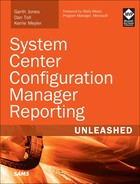Introduction
System Center Configuration Manager (ConfigMgr) stores a wealth of information about users, hardware, software inventory, software updates, applications, site status, and other Configuration Manager operations in a relational database. The trick is to know how to retrieve that data out of the SQL Server database and present it in meaningful, useful, and reusable reports.
Microsoft provides some out-of-the-box reports; however, these reports only scratch the surface of what is available for use by management, end users, and Configuration Manager administrators. This book is written based on the premise that ConfigMgr reporting is not very difficult if you use the concepts, tools, and techniques discussed throughout its chapters. It walks you through installing SQL Server Reporting Services (SSRS), understanding SQL views to find data in the Configuration Manager site database, writing SQL queries, designing and building basic reports, advanced reporting techniques, and using role-based administration to securely deliver reports to the individuals to whom they are intended. Here are the benefits System Center Configuration Manager Reporting Unleashed delivers:
![]() Enables an optimal installation of SSRS and Configuration Manager reporting
Enables an optimal installation of SSRS and Configuration Manager reporting
![]() Provides the tools to understand how to retrieve ConfigMgr data from its SQL Server database and to retrieve that data in the most efficient way
Provides the tools to understand how to retrieve ConfigMgr data from its SQL Server database and to retrieve that data in the most efficient way
![]() Simplifies report design and creation
Simplifies report design and creation
![]() Shows how to create reports that can be used with the role-based administration security feature of ConfigMgr and SSRS.
Shows how to create reports that can be used with the role-based administration security feature of ConfigMgr and SSRS.
Part I: Installing and Configuring SSRS for Configuration Manager
System Center Configuration Manager Reporting Unleashed begins with a guide to installing and configuring SSRS and Configuration Manager reporting. Chapter 1, “Installing SQL Server Reporting Services,” walks you through the steps in installing and configuring SSRS, including configuring email and enabling remote errors to assist with any troubleshooting that might be necessary. Chapter 2, “Installing and Configuring Configuration Manager Reporting,” continues the installation discussion by showing you how to configure the reporting services point and use ConfigMgr security roles to control access to reports. It also provides information on how to change the report logo used in the reports to one specific to your own organization.
Part II: About Data and Retrieval
Before creating reports, you need to understand the data kept in the ConfigMgr site database, the tools Microsoft provides to access that data, and how to effectively and efficiently use Transact-SQL queries to retrieve that data. Chapter 3, “Understanding Configuration Manager Data,” discusses where ConfigMgr stores its inventory data and how to find that information. It also introduces you to SQL Server Management Studio, the tool you use to write your queries. Chapter 4, “Transact-SQL Primer,” provides a concise tutorial of the sections in a SQL query, the best ways to retrieve data, SQL functions, how to use different data types, and how to join data from multiple views.
Part III: Using SSRS for Configuration Manager Reporting
Part III of this book focuses on reporting, including report design, best practices for developing and designing reports, basic and more advanced reporting concepts, features of SSRS reporting, and implementing role-based administration in ConfigMgr reports. Chapter 5, “Basic Report Design,” discusses considerations for report designs and the types of reports you can use in a report series. Chapter 6, “Building a Basic Report,” introduces report projects, data sources and data sets, and elements you use in creating a report. The topic of building reports is continued in Chapter 7, “Intermediate Reporting Concepts,” which discusses creating report templates, using report parameters to customize the content of your reports, and the different types of charts you can include in SSRS reports. Chapter 8, “SSRS Reporting Features,” covers even more reporting concepts, including using drillthroughs, using custom color palettes, and adding reports into SSRS. Chapter 9, “Role-Based Administration and Reporting,” wraps up the discussion by showing you how to integrate ConfigMgr role-based administration into your SQL queries to provide an additional level of security in terms of who can access your reports.
Part IV: Appendixes
By this time, you should have at your disposal all the tools necessary to become a Configuration Manager reporting expert. The last part of the book includes three appendixes:
![]() Appendix A, “Glossary,” includes acronyms and terms useful to know when working with Configuration Manager and SQL Server Reporting Services.
Appendix A, “Glossary,” includes acronyms and terms useful to know when working with Configuration Manager and SQL Server Reporting Services.
![]() Appendix B, “Demonstration Outcomes,” contains the expected outcome from all chapter demonstrations throughout this book.
Appendix B, “Demonstration Outcomes,” contains the expected outcome from all chapter demonstrations throughout this book.
![]() Appendix C, “Available Online,” discusses value-added content available for download under the Downloads tab at Pearson’s InformIT website, at www.informit.com/title/9780672337789.
Appendix C, “Available Online,” discusses value-added content available for download under the Downloads tab at Pearson’s InformIT website, at www.informit.com/title/9780672337789.
This book provides in-depth reference and technical information about System Center Configuration Manager reporting as well as information about other products and technologies on which its features and components depend.
Disclaimers and Fine Print
The authors want to offer several disclaimers. While the authors of System Center Configuration Manager Reporting Unleashed have made every attempt to present information that is accurate and current as known at the time, they are not infallible. In addition, screenshots were taken with version 1511, and it is certainly possible that Microsoft could slightly tweak the user interface in later versions.
Any updates and corrections will be provided as errata on the InformIT website.
Thank you for purchasing System Center Configuration Manager Reporting Unleashed. The authors hope it is worth your while.
